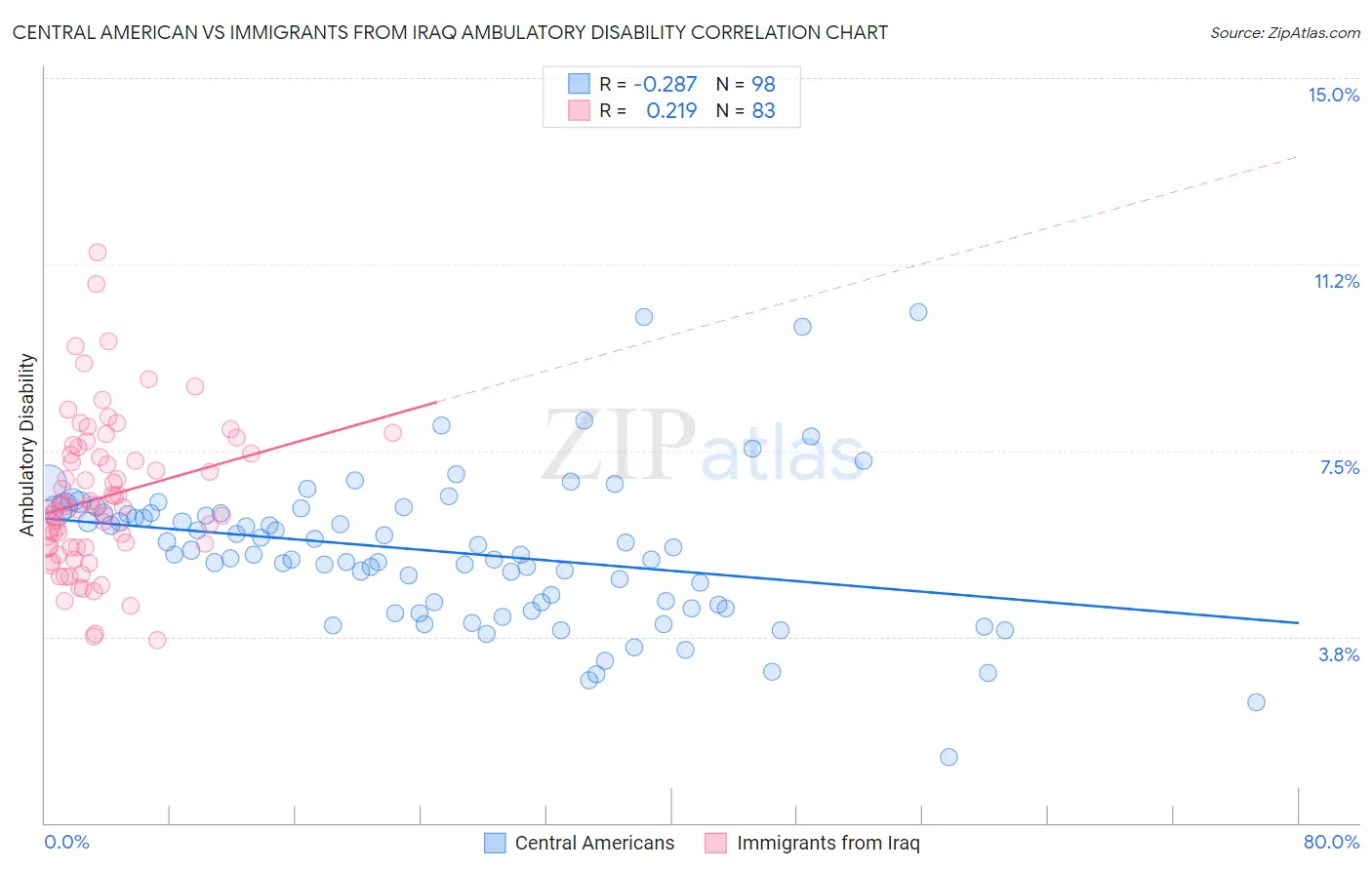Central American vs Immigrants from Iraq Ambulatory Disability
COMPARE
Central American
Immigrants from Iraq
Ambulatory Disability
Ambulatory Disability Comparison
Central Americans
Immigrants from Iraq
6.0%
AMBULATORY DISABILITY
69.8/ 100
METRIC RATING
160th/ 347
METRIC RANK
6.3%
AMBULATORY DISABILITY
14.0/ 100
METRIC RATING
209th/ 347
METRIC RANK
Central American vs Immigrants from Iraq Ambulatory Disability Correlation Chart
The statistical analysis conducted on geographies consisting of 504,305,341 people shows a weak negative correlation between the proportion of Central Americans and percentage of population with ambulatory disability in the United States with a correlation coefficient (R) of -0.287 and weighted average of 6.0%. Similarly, the statistical analysis conducted on geographies consisting of 194,765,362 people shows a weak positive correlation between the proportion of Immigrants from Iraq and percentage of population with ambulatory disability in the United States with a correlation coefficient (R) of 0.219 and weighted average of 6.3%, a difference of 3.6%.

Ambulatory Disability Correlation Summary
| Measurement | Central American | Immigrants from Iraq |
| Minimum | 1.3% | 3.7% |
| Maximum | 10.3% | 11.5% |
| Range | 9.0% | 7.8% |
| Mean | 5.5% | 6.6% |
| Median | 5.4% | 6.4% |
| Interquartile 25% (IQ1) | 4.4% | 5.6% |
| Interquartile 75% (IQ3) | 6.2% | 7.4% |
| Interquartile Range (IQR) | 1.9% | 1.9% |
| Standard Deviation (Sample) | 1.5% | 1.5% |
| Standard Deviation (Population) | 1.5% | 1.5% |
Similar Demographics by Ambulatory Disability
Demographics Similar to Central Americans by Ambulatory Disability
In terms of ambulatory disability, the demographic groups most similar to Central Americans are Immigrants from Belarus (6.1%, a difference of 0.040%), Immigrants from Fiji (6.0%, a difference of 0.080%), Immigrants from Latvia (6.0%, a difference of 0.080%), Ghanaian (6.0%, a difference of 0.10%), and Northern European (6.0%, a difference of 0.13%).
| Demographics | Rating | Rank | Ambulatory Disability |
| Syrians | 75.5 /100 | #153 | Good 6.0% |
| Immigrants | Croatia | 75.1 /100 | #154 | Good 6.0% |
| Immigrants | Scotland | 72.1 /100 | #155 | Good 6.0% |
| Northern Europeans | 71.8 /100 | #156 | Good 6.0% |
| Ghanaians | 71.3 /100 | #157 | Good 6.0% |
| Immigrants | Fiji | 71.2 /100 | #158 | Good 6.0% |
| Immigrants | Latvia | 71.1 /100 | #159 | Good 6.0% |
| Central Americans | 69.8 /100 | #160 | Good 6.0% |
| Immigrants | Belarus | 69.2 /100 | #161 | Good 6.1% |
| Nigerians | 67.1 /100 | #162 | Good 6.1% |
| Lebanese | 66.2 /100 | #163 | Good 6.1% |
| Basques | 63.7 /100 | #164 | Good 6.1% |
| Nicaraguans | 63.2 /100 | #165 | Good 6.1% |
| Iraqis | 62.8 /100 | #166 | Good 6.1% |
| Immigrants | Oceania | 60.7 /100 | #167 | Good 6.1% |
Demographics Similar to Immigrants from Iraq by Ambulatory Disability
In terms of ambulatory disability, the demographic groups most similar to Immigrants from Iraq are Bangladeshi (6.3%, a difference of 0.020%), Immigrants from Laos (6.3%, a difference of 0.080%), Alsatian (6.3%, a difference of 0.11%), Samoan (6.3%, a difference of 0.22%), and Mexican American Indian (6.3%, a difference of 0.23%).
| Demographics | Rating | Rank | Ambulatory Disability |
| Albanians | 19.7 /100 | #202 | Poor 6.2% |
| Immigrants | Ukraine | 18.4 /100 | #203 | Poor 6.2% |
| Immigrants | Congo | 18.2 /100 | #204 | Poor 6.2% |
| Slovenes | 18.0 /100 | #205 | Poor 6.2% |
| Finns | 17.2 /100 | #206 | Poor 6.2% |
| Alsatians | 15.1 /100 | #207 | Poor 6.3% |
| Bangladeshis | 14.2 /100 | #208 | Poor 6.3% |
| Immigrants | Iraq | 14.0 /100 | #209 | Poor 6.3% |
| Immigrants | Laos | 13.2 /100 | #210 | Poor 6.3% |
| Samoans | 12.1 /100 | #211 | Poor 6.3% |
| Mexican American Indians | 12.0 /100 | #212 | Poor 6.3% |
| Japanese | 12.0 /100 | #213 | Poor 6.3% |
| Immigrants | Mexico | 11.0 /100 | #214 | Poor 6.3% |
| Immigrants | Latin America | 11.0 /100 | #215 | Poor 6.3% |
| Canadians | 10.9 /100 | #216 | Poor 6.3% |